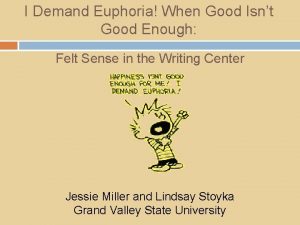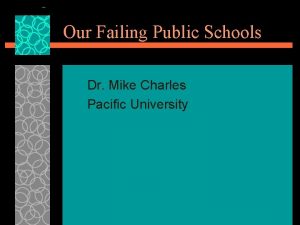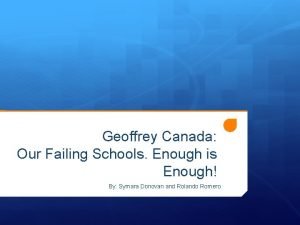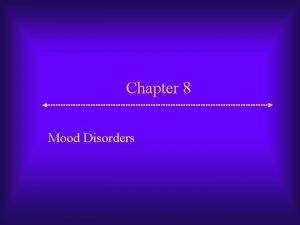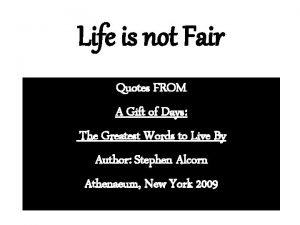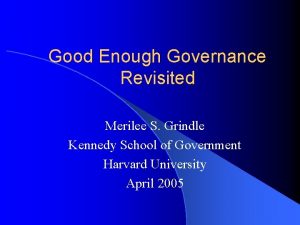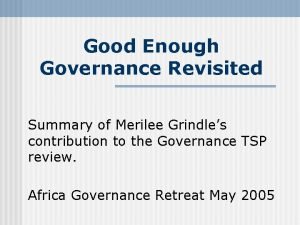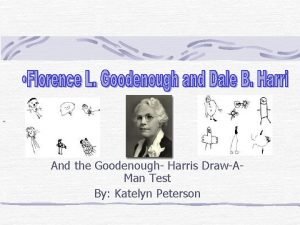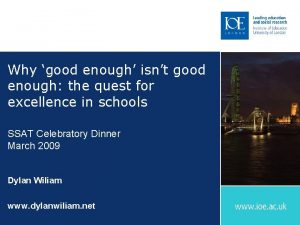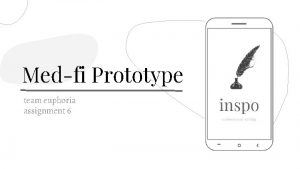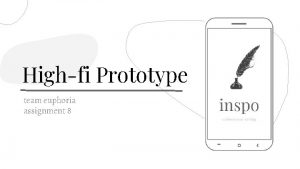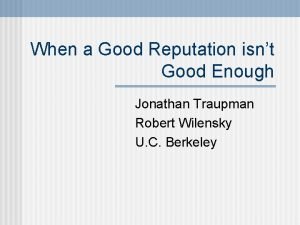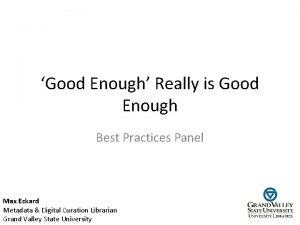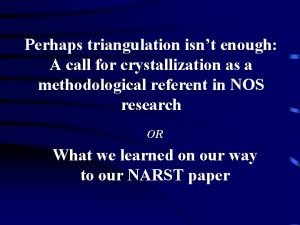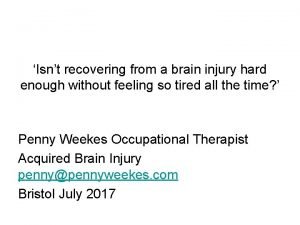I Demand Euphoria When Good Isnt Good Enough



![Definition “A kind of bodily awareness that…can be used as a tool…[and] encompasses everything Definition “A kind of bodily awareness that…can be used as a tool…[and] encompasses everything](https://slidetodoc.com/presentation_image_h2/4f28ce9c1d05c60527688df014e2991a/image-4.jpg)














- Slides: 18

I Demand Euphoria! When Good Isn’t Good Enough: Felt Sense in the Writing Center Jessie Miller and Lindsay Stoyka Grand Valley State University

Purpose and Takeaway Purpose � Present guidelines for consultants to help students use felt sense in their own writing based on primary and secondary research Takeaway: � Discover a new way to discuss writing � Equip consultants with strategies for working with students’ writing using felt sense

Overview 1. 2. 3. 4. 5. 6. Background Our Primary Research Methods Results Takeaway and Guidelines Conclusion
![Definition A kind of bodily awareness thatcan be used as a tooland encompasses everything Definition “A kind of bodily awareness that…can be used as a tool…[and] encompasses everything](https://slidetodoc.com/presentation_image_h2/4f28ce9c1d05c60527688df014e2991a/image-4.jpg)
Definition “A kind of bodily awareness that…can be used as a tool…[and] encompasses everything you feel and know about a given subject at a given time…. It is felt in the body, yet it has meanings. It is body and mind before they are split apart. ” -Eugene Gendlin

Background Information Can point us “to what is going on within us or to what lies beneath the words or to what lies at the edge of our thoughts” (Perl) Interpretation: � The inner voice/feelings that guide a piece � Can be positive or negative Examples: � Picking a topic � Speaking vs. writing

Our Primary Research Observed GVSU writing center consultations � Show consultants currently use felt sense Interviewed three GVSU writing professors � See how professionals have developed and use felt sense successfully in their writing Conducted case studies with 5 Consultants � Determine how instruction on felt sense can improve writing dialogue in a consultation

Methods: Observation and Interview Data Eight 30 min. consultations in the Writing Center � Identified instances when students or consultants referenced feelings Interviewed 3 GVSU writing professors � Asked Own two types of questions: writing process Responding to students

Methods: Case Study Determine whether instruction on felt sense would improve its use in consultations Conducted case study on 6 consultants: � Asked about previous knowledge on felt sense � Educated them on how to use felt sense in consultations � Conducted a follow-up with post-study survey

Results: Observations and Interviews Observations � Asking about feelings � Using feelings to guide consultation � Asking guiding and directive questions � Transcribing � Instilling trust between student and felt sense Interviews � Positive and negative felt sense � Can’t force students to use felt sense � Must eventually experience breakthrough to become a writer

Results: Case Studies Most consultants have a “general” understanding of felt sense With instruction and practice, consultants’ understanding and use of felt sense improves A consultant’s felt sense can play a role in a consultation Felt sense can be applicable at any stage of writing

Takeaway and Guidelines When to use felt sense Guidelines for Consultations: � Brainstorming � Expanding � Revising

When to Use Felt Sense With students who have a background knowledge of composition In creative writing With global issues When students self-identify feelings

When Felt Sense May Not Be a Reliable Tool With defeated students When editing In academic writing With international students When consultants rely too heavily on their own felt sense

Guidelines: Brainstorming 1. 2. 3. 4. Determine an obsession Find the interest and excitement in the obsession Discuss thoughts about interest Ask: Why does this matter?

Guidelines: Expanding Practice � Freewrite Rhetorical Strategies: � Topic vs Purpose � Audience and Context Metacognitive Stage: � What have you learned? � What new information have you found? � What piece of this is most interesting to you?

Guidelines: Revising Feeling-based questions � How do you feel about this paper? Guiding Questions � Why do you feel that? � What can we do with that? Directive Feedback � Where is your thesis statement?

Conclusion Felt sense is the physical and emotional reactions experienced while writing � Gives voice to what you already know When to Use It � Types of students � Types of writing Guidelines for consultations With practice and instruction, consultants can better apply it

Thank you! Any questions? stoykal@mail. gvsu. edu millerj 5@mail. gvsu. edu
 I demand euphoria
I demand euphoria Im good enough i'm smart enough
Im good enough i'm smart enough Too enough not enough
Too enough not enough Our failing schools enough is enough summary
Our failing schools enough is enough summary Our failing schools enough is enough
Our failing schools enough is enough A state of breathless euphoria or frenzied energy
A state of breathless euphoria or frenzied energy Isnt the love of jesus something wonderful
Isnt the love of jesus something wonderful Life not fair quotes
Life not fair quotes There isn't any burger
There isn't any burger Isnt he beautiful
Isnt he beautiful Notch glaucoma
Notch glaucoma Good enough governance
Good enough governance Good enough governance
Good enough governance Goodenough harris test
Goodenough harris test Close enough randy
Close enough randy This test isn't good enough in academic writing
This test isn't good enough in academic writing Module 5 supply and demand introduction and demand
Module 5 supply and demand introduction and demand Independent demand adalah
Independent demand adalah Methods of demand forecasting in managerial economics
Methods of demand forecasting in managerial economics
